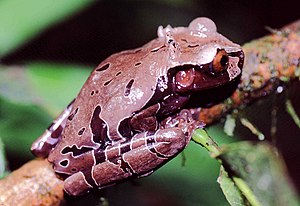Crowned tree frog
| Crowned tree frog | ||||||||||||
|---|---|---|---|---|---|---|---|---|---|---|---|---|

Crowned tree frog ( Triprion spinosus ) |
||||||||||||
| Systematics | ||||||||||||
|
||||||||||||
| Scientific name | ||||||||||||
| Triprion spinosus | ||||||||||||
| ( Steindachner , 1864) |
The crowned tree frog ( Triprion spinosus , syn .: Anotheca spinosa , Anotheca coronata , Gastrotheca coronata , Nototrema coronatum ,) is a little known representative of the tree frogs (Hylidae).
This species was first described as Hyla spinosa by the Austrian zoologist Franz Steindachner in 1864 .
description
The females are up to eight centimeters head-trunk length about 10-15 percent larger than the males. The dark brown animals are drawn with black spots, which are outlined in white. The characteristic of this species are thorn-like bones on the back of the head that exist in both sexes. These grow partially out of the skin and give the frog its distinctive appearance, which led to the name part "Kronen- ...". This characteristic is not yet present in young animals and only develops over time. The eardrum is extremely large.
Occurrence
The distribution of the crowned tree frog is highly disjoint . Brazil was originally given as terra typica ; however, this is due to a mix-up. The distribution area of the crowned tree frog stretches island-like from southeast Mexico (800 to 2068 m above sea level ) via Honduras (95 m above sea level) and Costa Rica (350 to 1330 m above sea level) to western and central Panama (350 to 1330 m above sea level). There, the species inhabits lowland rainforests and moist mountain forests, where these have also been cleared as secondary forests .
Way of life
Crowned tree frogs inhabit the upper floors of treetops in the mountain rainforest ; this is precisely why the species has only been little researched. Like most frogs, it probably feeds on insects .
Little is known about reproduction either. Males call out from water-filled tree hollows or openings in bamboo to attract females. During mating, the 48 to 311 eggs with a diameter of 1.5 to 1.8 millimeters are laid in phytotelms (water accumulations in plants) within two to four hours during the day . In the case of the amplexus , crowned tree frogs usually go head first into the water so that the openings in the cloaca remain above the water. The eggs are laid on the plants outside of the water; then the tree cavity is left. The male either mates with the female again or calls another phytothelium for a female. After about six to seven days, despite the large number of eggs, only about one to 25 tadpoles hatch , which are dark brown on the top and blue-gray on the bottom.
The female will later return to this cave and lay up to 31 unfertilized eggs. This is repeated several times within 14 days. These eggs serve as food for the tadpoles. The female is stimulated by the tadpoles to lay her eggs. When a new fertilized clutch is released, the smaller larvae serve as food for the older specimens and are quickly eaten. The tadpoles are able to breathe atmospheric air and thus circumvent the problem of a lack of oxygen in the limited water supply in the phytothelms. After 60 to 132 days, the metamorphosis takes place , after which young frogs around 26 to 28 millimeters in size leave the cave.
Danger
The population of the species is declining slightly, but it is shown in the IUCN's Red List of Threatened Species as not threatened ( least concern ). The clearing of the rainforest is primarily responsible for the decline in the population. The crowned tree frog, however, is comparatively adaptable and also inhabits secondary forests , and large parts of its range are in protected areas; the survival of the species seems assured.
Web links
swell
Individual evidence
- ↑ American Museum of Natural History ( Memento of the original from January 8, 2007 in the Internet Archive ) Info: The archive link was inserted automatically and has not yet been checked. Please check the original and archive link according to the instructions and then remove this notice. .
- ↑ Global Amphibian Assessment: Anotheca spinosa ( page no longer available , search in web archives ) Info: The link was automatically marked as defective. Please check the link according to the instructions and then remove this notice. (including a distribution map).
- ↑ a b Triprion spinous in the endangered Red List species the IUCN 2010. Posted by: Georgina Santos-Barrera, Oscar Flores-Villela, Frank Solís, Roberto Ibáñez, Jay Savage, Gerardo Chaves, Brian Kubicki, 2008. Accessed January 24 2011.
literature
- Peter Janzen: Species portrait: The crowned tree frog Anotheca spinosa (Steindachner, 1864) . In: Amphibia, 6th year, issue 2/2007: pp. 20–22. ISSN 1619-9952
- Karl-Heinz Jungfer (1996): Reproduction and parental care of the coronated treefrog, Anotheca spinosa (Steindachner, 1864) (Anura: Hylidae). Herpetologica 52 (1): 25-32.